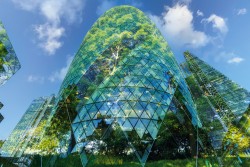Reducing the environmental impact of projects has never been more important. Here, Paul Whittall, Business Development Manager at Uponor explains how choosing the right products from a responsible supply chain partner can enhance the sustainability of offsite projects, and what Uponor is doing to support customers in this area.
One of the key drivers behind the use of offsite construction is the improved sustainability it can offer compared with conventional approaches. It can reduce waste through the better control of processes and more precise cutting of materials that the factory environment enables. This environment can also help ensure that waste is sorted effectively, and the recycling of materials is maximised. Furthermore, with a controlled factory environment, higher standards of construction can be achieved more easily. This can allow improved energy efficiency for the building when in use. For example, greater precision means better airtightness and, in turn, smaller heat losses. Through more efficient and consolidated movement of materials, offsite construction can also help reduce the emissions from transportation associated with the project.
However, these benefits are not intrinsic to the process and will depend on how the offsite element, as well as the construction on site, is managed. The environmental impact of the building can also be minimised through careful selection of the products, systems and components used.
Embodied carbon – the emissions associated with building components from raw materials, through manufacturing to installation in the building – is increasingly being recognised as having equal importance as the operational emissions from heating, cooling, lighting and power. Therefore, it is essential that the products themselves as well as the sustainability commitments of the manufacturers are considered carefully.
An important part of reducing the embodied carbon of a building is ensuring the products and systems used have a long lifespan. This is because replacing products multiple times during the lifespan of the building is not only costly in the long run but increases the total carbon footprint. In fact, the Royal Institute of British Architects' (RIBA) analysis suggests that for residential developments, maintenance and the replacement of building components may account for as much as 18% of total carbon throughout the building's lifespan.
Therefore, choosing high quality products constructed from materials with proven longevity is always recommended. To help determine this, manufacturers should be able to provide lifecycle analyses for their products to allow comparisons of different options. This is an area that Uponor focuses on and has made significant investment to help customers make informed decisions.
Multi-layer composite pipe (MLCP), for example, is a material suited to offsite processes that can offer impressive longevity. For example, our MLCP, which is constructed from high-quality PEX-a and aluminium, has a lifespan of over 100 years. MLCP is ideal for offsite construction due to its strength and the flexibility that allows it to be formed into bends rather than being cut and connected to achieve changes in direction. It is also easy to install with no specialist skills required.
Another consideration from a sustainability perspective is the weight of the product. Here MLCP also has clear advantages as it is lighter than alternatives such as copper. This means lower emissions when transporting it from the manufacturer to the offsite facility, as well as moving the modules or panels to site.
In addition, it is also worth looking for products that are manufactured from low carbon or sustainably sourced materials. For example, our PEX Blue products are the world's first bio-based PEX pipes and have a carbon footprint that is up to 90% lower than fossil-based alternatives. In fact, this innovative solution to carbon reduction was shortlisted for the CIBSE Embodied Carbon Award in 2023. We are also investing in a new pilot scheme to chemically recycle old pipe removed from buildings to produce new pipe.
Finally, it is also essential to consider how the operations of supply partners will influence the overall environmental impact of the project. For example, at Uponor we are continually working towards improved sustainability for our business. We have made a commitment to achieve net zero in our operations by 2040, a decade ahead of the target set by the UK, the EU and many other leading world economies. The steps we have already made include using certified green energy for 98% of the energy required for our manufacturing processes and recycling 83% of our waste as material or energy.
Offsite construction has the potential to improve the environmental impact of buildings. However, a holistic approach must be taken, with the choice of products and the sustainable practices of suppliers also factored in. At Uponor we are committed to helping our customers achieve their goals, including making the most sustainable choices.
To find out more about the services and support Uponor can offer, as well as its range of products visit www.uponor.com/en-gb









